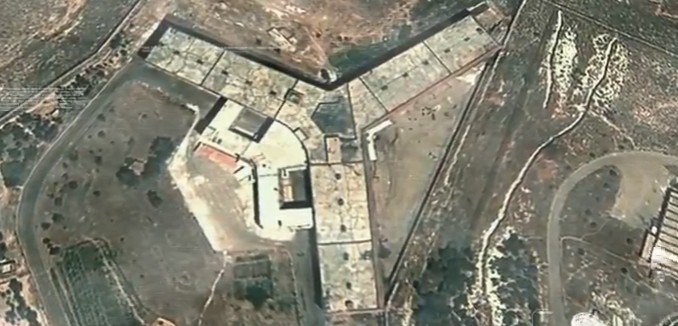Up to 13,000 people were secretly killed over five years in a notorious Syrian prison run by the Iran-backed regime of Bashar al-Assad, Amnesty International revealed in a report on Tuesday.
Saydnaya Prison, located some 30 miles north of Damascus, is the site of a “campaign of mass hangings and extermination,” complete with “repeated torture and the systematic deprivation of food, water, medicine and medical care,” Amnesty charged. The report is based on testimony collected between December 2015 to December 2016 from over 80 witnesses, including soldiers, judges, and prisoners who survived Saydnaya.
According to Amnesty, prisoners at the “human slaughterhouse” — largely civilians believed to be opposed to the Assad regime — would be blindfolded and taken from their cells in batches of 20 to 50 once a week, then beaten and hanged. Those who were too light to die by hanging would be taken down and have their necks broken. The corpses were then buried in unmarked mass graves, with no notification given to their families.
“If you put your ears on the floor, you could hear the sound of a kind of gurgling,” said a former detainee who was held in the floor above the execution room. “This would last around 10 minutes … We were sleeping on top of the sound of people choking to death. This was normal for me then.”
The report described the executions as “so summary and arbitrary that they cannot be considered to constitute judicial process.” One former judge from a Syrian military court explained that “the judge will ask the name of the detainee and whether he committed the crime. Whether the answer is yes or no, he will be convicted … This court has no relation with the rule of law. This is not a court.”
Many of the prisoners who spoke to Amnesty said they were raped and in some cases forced to rape others. Torture and beatings were regularly meted out by the guards, and the floors of the cells were coated with blood and pus from the victims’ wounds. Food and water were often cut off, and when rations were delivered, they were often thrown on the ground to mix with blood and dirt. The bodies of dead detainees would be collected by prison guards every morning around 9am. Those few who left Saydnaya alive often weighed half of what they did when they arrived.
According to Amnesty, these practices “are authorized at the highest levels of the Syrian government” and “amount to war crimes and crimes against humanity.”
“The horrors depicted in this report reveal a hidden, monstrous campaign, authorized at the highest levels of the Syrian government, aimed at crushing any form of dissent within the Syrian population,” said Lynn Maalouf, deputy director for research at Amnesty’s regional office in Beirut.
“A firm decision must be made by the UN Security Council. It cannot turn a blind eye to these horrible crimes and must pass a resolution demanding that the Syrian government opens up its prisons for international monitors. The UN Human Rights Council must immediately demand an independent investigation into these grave violations of international law,” Maalouf said. She added that while Amnesty’s investigation focuses on the period from 2011 to 2015, there is no reason to believe that the torture and killings have stopped.
The Assad regime has long been accused of committing war crimes over the course of the Syrian civil war, which began in 2011 with peaceful protests against his rule. In a statement released last August, the United States Holocaust Memorial Museum warned:ongogin
President Bashar al-Assad and his government are committing crimes against humanity and war crimes against civilians, including acts of mass killing, torture and targeted attacks on medical facilities and health care providers. The denial of humanitarian assistance and the regime’s intentional starvation of this population through a siege are war crimes. The government has used these same tactics over the past five years in eastern Homs, Idlib and numerous other towns and cities, leading to large-scale loss of life.
Consistent with the Amnesty report, the United Nations formally accused Assad in February of last year of authorizing the “extermination” of prisoners.
The New Yorker reported in April 2016 on efforts by the Commission for International Justice and Accountability (CIJA) to help establish the culpability of the high-ranking Assad regime officials who authorize war crimes.
The documentation and testimony being gathered by CIJA has been supplemented by photographs of the regime’s thousands of torture and murder victims, which were smuggled out of Syria by a former military police photographer known as Caesar.
Steven Rapp, then the top war crimes official for the U.S. government, declared in July 2014 that the Caesar’s photographs provided “solid evidence of the kind of machinery of cruel death that we haven’t seen frankly since the Nazis.”
The U.S. House of Representatives overwhelmingly approved a resolution last March calling for a tribunal to prosecute Assad and his allies for war crimes. The non-binding measure, which passed 392-3, denounced a litany of crimes perpetrated by the Assad regime, including having committed “widespread torture and rape, employed starvation as a weapon of war, and massacred civilians, including through the use of chemical weapons, cluster munitions, and barrel bombs;… [and] subjected nearly 1 million civilians to devastating sieges and manipulated the delivery of humanitarian aid for its own gain, thereby weaponizing starvation against populations.” It notably cast blame on the Assad regime, as well as “the Russian Federation, the Islamic Republic of Iran, and Iran’s terrorist proxies including Hezbollah,” for killing the “vast majority” of Syrian civilians who have died in the conflict.
The UN stopped counting the death toll of the Syrian civil war in 2014, when it had reached 250,000.
[Photo: laisart company / YouTube ]




